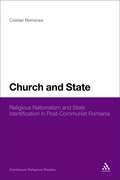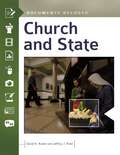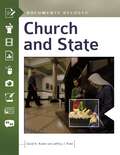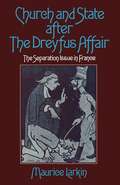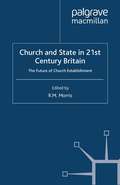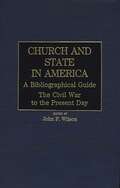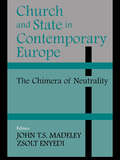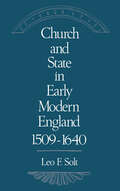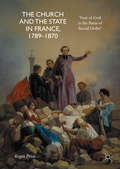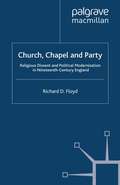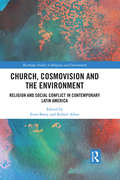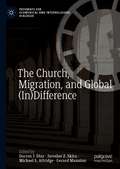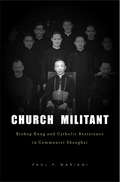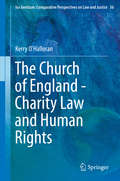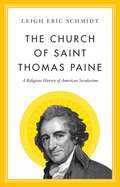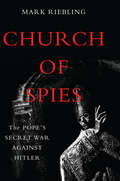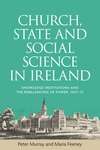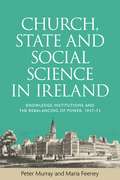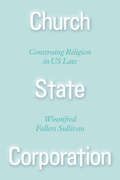- Table View
- List View
Church and State: Religious Nationalism and State Identification in Post-Communist Romania
by Cristian RomoceaTwenty years have passed since the fall of the Iron Curtain, yet emerging democracies continue to struggle with a secular state which does not give preference to churches as major political players. This book explores the nationalist inclinations of an Eastern Orthodox Church as it interacts with a politically immature yet decisively democratic Eastern European state. Discussing the birth pangs of extreme nationalist movements of the twentieth century, it offers a creative retelling of the ideological idiosyncrasies which have characterized Marxist Communism and Nazism. Cristian Romocea provides a constant juxtaposition of the ideological movements as they interacted and affected organized religion, at times seeking to remove it, assimilate it or even imitate it. Of interest to historians, theologians and politicians, this book introduces the reader, through a case study of Romania, to relevant and contemporary challenges churches worldwide are facing in a context characterized by increased secularization of the state and radicalization of religion.
Church and State: Religious Nationalism and State Identification in Post-Communist Romania
by Cristian RomoceaTwenty years have passed since the fall of the Iron Curtain, yet emerging democracies continue to struggle with a secular state which does not give preference to churches as major political players. This book explores the nationalist inclinations of an Eastern Orthodox Church as it interacts with a politically immature yet decisively democratic Eastern European state. Discussing the birth pangs of extreme nationalist movements of the twentieth century, it offers a creative retelling of the ideological idiosyncrasies which have characterized Marxist Communism and Nazism. Cristian Romocea provides a constant juxtaposition of the ideological movements as they interacted and affected organized religion, at times seeking to remove it, assimilate it or even imitate it. Of interest to historians, theologians and politicians, this book introduces the reader, through a case study of Romania, to relevant and contemporary challenges churches worldwide are facing in a context characterized by increased secularization of the state and radicalization of religion.
Church and State: Documents Decoded (Documents Decoded)
by David K. Ryden Jeffrey J. PoletThis thoroughly annotated document collection gives students and researchers an authoritative source for understanding the evolving political and legal relationship between church and state from colonial times to the present day.The First Amendment to the Constitution of the United States declares that "Congress shall make no law respecting an establishment of religion, or prohibiting the free exercise thereof." The Establishment Clause, meanwhile, declares a position of neutrality not only between differing religions, but between religious and nonreligious beliefs. The terms of the Free Exercise Clause, however, provide special protections to religious belief and practice. Thus the provisions of the two clauses can clash. In fact, differing political and legal interpretations of these clauses have resulted in some of the most hard-fought and contentious philosophical battles in American history.This book provides readers with convenient access to pertinent documents and court cases that enables a deeper understanding of the past and current balance between church and state and its political implications in the 21st century. The expert commentary that accompanies these key documents serves to elucidate how interpretation of the U.S. Constitution affects issues such as whether public funds or other public support should go to religious-based schools or hospitals; how to safeguard individuals' rights to religious expression while also considering how individuals should not be forced to participate in mandatory religious expressions in public institutions; and how the language regarding "separation of church and state" came about, when this phrase does not appear anywhere in the Constitution.
Church and State: Documents Decoded (Documents Decoded)
by David K. Ryden Jeffrey J. PoletThis thoroughly annotated document collection gives students and researchers an authoritative source for understanding the evolving political and legal relationship between church and state from colonial times to the present day.The First Amendment to the Constitution of the United States declares that "Congress shall make no law respecting an establishment of religion, or prohibiting the free exercise thereof." The Establishment Clause, meanwhile, declares a position of neutrality not only between differing religions, but between religious and nonreligious beliefs. The terms of the Free Exercise Clause, however, provide special protections to religious belief and practice. Thus the provisions of the two clauses can clash. In fact, differing political and legal interpretations of these clauses have resulted in some of the most hard-fought and contentious philosophical battles in American history.This book provides readers with convenient access to pertinent documents and court cases that enables a deeper understanding of the past and current balance between church and state and its political implications in the 21st century. The expert commentary that accompanies these key documents serves to elucidate how interpretation of the U.S. Constitution affects issues such as whether public funds or other public support should go to religious-based schools or hospitals; how to safeguard individuals' rights to religious expression while also considering how individuals should not be forced to participate in mandatory religious expressions in public institutions; and how the language regarding "separation of church and state" came about, when this phrase does not appear anywhere in the Constitution.
Church and State in 21st Century Britain: The Future of Church Establishment
by R. MorrisWith Church establishment largely locked in the geopolitics of the late 17th century, this study examines the case for change. How should the constitution respond to an ever more pluralized society; what are the implications for the religious character of the monarchy? This book helps readers consider such questions and reach their own judgments.
Church and State in America: The Civil War to the Present Day
by Bloomsbury PublishingThe second in a two-volume bibliography on church-state relations in U.S. history, this book contains eleven critical essays and accompanying bibliographical listings on periods or topics from the Civil War to the present day. Each essay reviews the available relevant literature, and the listings emphasize critical studies and documents published in the last quarter-century. This reference work will enable the reader to grasp the historiographic issues, become acquainted with the resources available, and move on to interpret current as well as past issues more knowledgebly and effectively.
Church and State in Contemporary Europe
by Zsolt Enyedi John T. S. MadeleyThis volume represents an attempt in integrating a wide range of theoretically relevant issues into the identification and analysis of church-state patterns. Each chapter focuses on the analysis of a particular theme and its role in shaping, and/or being shaped by, church-state relations.
Church and State in Contemporary Europe
by John T. S. Madeley Zsolt EnyediThis volume represents an attempt in integrating a wide range of theoretically relevant issues into the identification and analysis of church-state patterns. Each chapter focuses on the analysis of a particular theme and its role in shaping, and/or being shaped by, church-state relations.
Church and State in Early Modern England, 1509-1640
by Leo F. SoltThe relationship between church and state, indeed between religion and politics, has been one of the most significant themes in early modern English history. While scores of specialized studies have greatly advanced scholars' understanding of particular aspects of this period, there is no general overview that takes into account current scholarship. This volume discharges that task. Solt seeks to provide the main contours of church-state connections in England from 1509 to 1640 through a selective narration of events interspersed with interpretive summaries. Since World War II, social and economic explanations have dominated the interpretation of events in Tudor and early Stuart England. While these explanations continue to be influential, religious and political explanations have once again come to the fore. Drawing extensively from both primary and secondary sources, Solt provides a scholarly synthesis that combines the findings of earlier research with the more recent emphasis on the impact of religion on political events and vice versa.
The Church and the State in France, 1789-1870: 'Fear of God is the Basis of Social Order'
by Roger PriceThis book explores the responses of the Roman Catholic Church to the French Revolution beginning in 1789, to the liberal revolution in 1830, and particularly the democratic revolution of 1848 in France, and asks how these events were perceived and explained. Informed by the collective memory of the first revolution, how did the Church react to renewed ‘catastrophe’? How did it seek to influence political choice? Why did authoritarian government prove to be so attractive? This is a study of the impact of religion on political behaviour, as well as of the politicisation of religion. Roger Price employs the methodology of the social and cultural historian to explain the development and interaction of two key institutions, Church and State, during a period of political and social upheaval. Drawing on a wide range of archival and printed primary sources, as well as secondary literature, this book analyses the diverse perceptions of people with power and the impact of their decisions, and the responses, of a wide range of individuals and communities.
The Church and the State in France, 1789-1870: 'Fear of God is the Basis of Social Order'
by Roger PriceThis book explores the responses of the Roman Catholic Church to the French Revolution beginning in 1789, to the liberal revolution in 1830, and particularly the democratic revolution of 1848 in France, and asks how these events were perceived and explained. Informed by the collective memory of the first revolution, how did the Church react to renewed ‘catastrophe’? How did it seek to influence political choice? Why did authoritarian government prove to be so attractive? This is a study of the impact of religion on political behaviour, as well as of the politicisation of religion. Roger Price employs the methodology of the social and cultural historian to explain the development and interaction of two key institutions, Church and State, during a period of political and social upheaval. Drawing on a wide range of archival and printed primary sources, as well as secondary literature, this book analyses the diverse perceptions of people with power and the impact of their decisions, and the responses, of a wide range of individuals and communities.
Church, Chapel and Party: Religious Dissent and Political Modernization in Nineteenth-Century England (Studies in Modern History)
by Richard D. FloydThrough close examination of dozens of electoral contests in carefully chosen constituencies, the author demonstrates that the fundamental division separating the burgeoning liberal and conservative parties in England in the 1830s and 1840s was religion, and that this controversy was what created a perceptible two-party system in British politics.
Church, Cosmovision and the Environment: Religion and Social Conflict in Contemporary Latin America (Routledge Studies in Religion and Environment)
by Evan Berry Robert AlbroThough currently only partially understood, evolving interactions among Latin American communities of faith, governments, and civil societies are a key feature of the popular mobilizations and policy debates about environmental issues in the region. This edited collection describes and analyses multiple types of religious engagement with environmental concerns and conflicts seen in modern Latin American democracies. This volume contributes to scholarship on the intersections of religion with environmental conflict in a number of ways. Firstly, it provides comparative analysis of the manner in which diverse religious actors are currently participating in transnational, national, and local advocacy in places such as, Peru, Argentina, Brazil, Bolivia, Ecuador, Guatemala, and Mexico. It also considers the diversity of an often plural religious engagement with advocacy, including Catholic, Evangelical and Pentecostal perspectives alongside the effects of indigenous cosmological ideas. Finally, this book explores the specific religious sources of seemingly unlikely new alliances and novel articulations of rights, social justice, and ethics for the environmental concerns of Latin America. The relationship between religion and environmental issues is an increasingly important topic in the conversations around ecology and climate change. This book is, therefore, a pertinent and topical work for any academic working in Religious Studies, Environmental Studies, and Latin American Studies.
Church, Cosmovision and the Environment: Religion and Social Conflict in Contemporary Latin America (Routledge Studies in Religion and Environment)
by Evan Berry Robert AlbroThough currently only partially understood, evolving interactions among Latin American communities of faith, governments, and civil societies are a key feature of the popular mobilizations and policy debates about environmental issues in the region. This edited collection describes and analyses multiple types of religious engagement with environmental concerns and conflicts seen in modern Latin American democracies. This volume contributes to scholarship on the intersections of religion with environmental conflict in a number of ways. Firstly, it provides comparative analysis of the manner in which diverse religious actors are currently participating in transnational, national, and local advocacy in places such as, Peru, Argentina, Brazil, Bolivia, Ecuador, Guatemala, and Mexico. It also considers the diversity of an often plural religious engagement with advocacy, including Catholic, Evangelical and Pentecostal perspectives alongside the effects of indigenous cosmological ideas. Finally, this book explores the specific religious sources of seemingly unlikely new alliances and novel articulations of rights, social justice, and ethics for the environmental concerns of Latin America. The relationship between religion and environmental issues is an increasingly important topic in the conversations around ecology and climate change. This book is, therefore, a pertinent and topical work for any academic working in Religious Studies, Environmental Studies, and Latin American Studies.
The Church, Migration, and Global (Pathways for Ecumenical and Interreligious Dialogue)
by Darren J. Dias Jaroslav Z. Skira Michael S. Attridge Gerard MannionThe painful reality faced by refugees and migrants is one of the greatest moral challenges of our time, in turn, becoming a focus of significant scholarship. This volume examines the global phenomenon of migration in its theological, historical, and socio-political dimensions and of how churches and faith communities have responded to the challenges of such mass human movement. The contributions reflect global perspectives with contributions from African, Asian, European, North American, and South American scholars and contexts. The essays are interdisciplinary, at the intersection of religion, anthropology, history, political science, gender and post-colonial studies. The volume brings together a variety of perspectives, inter-related by ecclesiological and theological concerns.
Church Militant: Bishop Kung and Catholic Resistance in Communist Shanghai
by Paul P. MarianiBy 1952 the Chinese Communist Party had suppressed all organized resistance to its regime and stood unopposed, or so it has been believed. Internal party documents—declassified just long enough for historian Paul Mariani to send copies out of China—disclose that one group deemed an enemy of the state held out after the others had fallen. A party report from Shanghai marked “top-secret” reveals a determined, often courageous resistance by the local Catholic Church. Drawing on centuries of experience in struggling with the Chinese authorities, the Church was proving a stubborn match for the party. Mariani tells the story of how Bishop (later Cardinal) Ignatius Kung Pinmei, the Jesuits, and the Catholic Youth resisted the regime’s punishing assault on the Shanghai Catholic community and refused to renounce the pope and the Church in Rome. Acting clandestinely, mirroring tactics used by the previously underground CCP, Shanghai’s Catholics persevered until 1955, when the party arrested Kung and 1,200 other leading Catholics. The imprisoned believers were later shocked to learn that the betrayal had come from within their own ranks. Though the CCP could not eradicate the Catholic Church in China, it succeeded in dividing it. Mariani’s secret history traces the origins of a deep split in the Chinese Catholic community, where relations between the “Patriotic” and underground churches remain strained even today.
The Church of England - Charity Law and Human Rights (Ius Gentium: Comparative Perspectives on Law and Justice #36)
by Kerry O'HalloranThis book examines the interface between religion, charity law and human rights. It does so by treating the Church of England and its current circumstances as a timely case study providing an opportunity to examine the tensions that have now become such a characteristic feature of that interface.Firstly, it suggests that the Church is the primary source of canon law principles that have played a formative role in shaping civic morality throughout the common law jurisdictions: the history of their emergence and enforcement by the State in post-Reformation England is recorded and assessed. Secondly, it reveals that of such principles those of greatest weight were associated with matters of sexuality: in particular, for centuries, family law was formulated and applied with regard for the sanctity of the heterosexual marital family which provided the only legally permissible context for any form of sexual relationship. Thirdly, given that history, it identifies and assesses the particular implications that now arise for the Church as a consequence of recent charity law reform outcomes and human rights case law developments: a comparative analysis of religion related case law is provided. Finally, following an outline of the structure and organizational functions of the Church, a detailed analysis is undertaken of its success in engaging with these issues in the context of the Lambeth Conferences, the wider Anglican Communion and in the ill-fated Covenant initiative.From the perspective of the dilemmas currently challenging the moral authority of the Church of England, this book identifies and explores the contemporary ‘moral imperatives’ or red line issues that now threaten the coherence of Christian religions in most leading common law nations. Gay marriage and abortion are among the host of morally charged and deeply divisive topics demanding a reasoned response and leadership from religious bodies. Attention is given to the judicial interpretation and evaluation of these and other issues that now undermine the traditional role of the Church of England. As the interface between religion, charity law and human rights becomes steadily more fractious, with religious fundamentalism and discrimination acquiring a higher profile, there is now a pressing need for a more balanced relationship between those with and those without religious beliefs.This book will be an invaluable aid in starting the process of achieving a triangulated relationship between the principles of canon law, charity law and human rights law.
The Church of Saint Thomas Paine: A Religious History of American Secularism
by Leigh Eric SchmidtThe forgotten story of the nineteenth-century freethinkers and twentieth-century humanists who tried to build their own secular religionIn The Church of Saint Thomas Paine, Leigh Eric Schmidt tells the surprising story of how freethinking liberals in nineteenth-century America promoted a secular religion of humanity centered on the deistic revolutionary Thomas Paine (1737–1809) and how their descendants eventually became embroiled in the culture wars of the late twentieth century.After Paine’s remains were stolen from his grave in New Rochelle, New York, and shipped to England in 1819, the reverence of his American disciples took a material turn in a long search for his relics. Paine’s birthday was always a red-letter day for these believers in democratic cosmopolitanism and philanthropic benevolence, but they expanded their program to include a broader array of rites and ceremonies, particularly funerals free of Christian supervision. They also worked to establish their own churches and congregations in which to practice their religion of secularism.All of these activities raised serious questions about the very definition of religion and whether it included nontheistic fellowships and humanistic associations—a dispute that erupted again in the second half of the twentieth century. As right-wing Christians came to see secular humanism as the most dangerous religion imaginable, small communities of religious humanists, the heirs of Paine’s followers, were swept up in new battles about religion’s public contours and secularism’s moral perils.An engrossing account of an important but little-known chapter in American history, The Church of Saint Thomas Paine reveals why the lines between religion and secularism are often much blurrier than we imagine.
Church of Spies: The Pope's Secret War Against Hitler
by Mark RieblingThe heart-pounding history of how Pope Pius XII -- often labeled "Hitler's Pope" -- was in fact an anti-Nazi spymaster, plotting against the Third Reich during World War II.The Vatican's silence in the face of Nazi atrocities remains one of the great controversies of our time. History has accused wartime pontiff Pius the Twelfth of complicity in the Holocaust and dubbed him "Hitler's Pope." But a key part of the story has remained untold.Pope Pius in fact ran the world's largest church, smallest state, and oldest spy service. Saintly but secretive, he sent birthday cards to Hitler -- while secretly plotting to kill him. He skimmed from church charities to pay covert couriers, and surreptitiously tape-recorded his meetings with top Nazis. Under his leadership the Vatican spy ring actively plotted against the Third Reich.Told with heart-pounding suspense and drawing on secret transcripts and unsealed files by an acclaimed author, Church of Spies throws open the Vatican's doors to reveal some of the most astonishing events in the history of the papacy. Riebling reveals here how the world's greatest moral institution met the greatest moral crisis in history.
Church, state and social science in Ireland: Knowledge institutions and the rebalancing of power, 1937–73
by Peter Murray Maria FeeneyThe immense power the Catholic Church once wielded in Ireland has considerably diminished over the last fifty years. During the same period the Irish state has pursued new economic and social development goals by wooing foreign investors and throwing the state's lot in with an ever-widening European integration project. How a less powerful church and a more assertive state related to one another during the key third quarter of the twentieth century is the subject of this book. Drawing on newly available material, it looks at how social science, which had been a church monopoly, was taken over and bent to new purposes by politicians and civil servants. This case study casts new light on wider processes of change, and the story features a strong and somewhat surprising cast of characters ranging from Sean Lemass and T.K. Whitaker to Archbishop John Charles McQuaid and Father Denis Fahey.
Church, state and social science in Ireland: Knowledge institutions and the rebalancing of power, 1937–73
by Peter Murray Maria FeeneyThe immense power the Catholic Church once wielded in Ireland has considerably diminished over the last fifty years. During the same period the Irish state has pursued new economic and social development goals by wooing foreign investors and throwing the state's lot in with an ever-widening European integration project. How a less powerful church and a more assertive state related to one another during the key third quarter of the twentieth century is the subject of this book. Drawing on newly available material, it looks at how social science, which had been a church monopoly, was taken over and bent to new purposes by politicians and civil servants. This case study casts new light on wider processes of change, and the story features a strong and somewhat surprising cast of characters ranging from Sean Lemass and T.K. Whitaker to Archbishop John Charles McQuaid and Father Denis Fahey.
Church State Corporation: Construing Religion in US Law
by Winnifred Fallers SullivanChurch and state: a simple phrase that reflects one of the most famous and fraught relationships in the history of the United States. But what exactly is “the church,” and how is it understood in US law today? In Church State Corporation, religion and law scholar Winnifred Fallers Sullivan uncovers the deeply ambiguous and often unacknowledged ways in which Christian theology remains alive and at work in the American legal imagination. Through readings of the opinions of the US Supreme Court and other legal texts, Sullivan shows how “the church” as a religious collective is granted special privilege in US law. In-depth analyses of Hosanna-Tabor v. EEOC and Burwell v. Hobby Lobby reveal that the law tends to honor the religious rights of the group—whether in the form of a church, as in Hosanna-Tabor, or in corporate form, as in Hobby Lobby—over the rights of the individual, offering corporate religious entities an autonomy denied to their respective members. In discussing the various communities that construct the “church-shaped space” in American law, Sullivan also delves into disputes over church property, the legal exploitation of the black church in the criminal justice system, and the recent case of Masterpiece Cakeshop v. Colorado Civil Rights Commission. Brimming with insight, Church State Corporation provocatively challenges our most basic beliefs about the ties between religion and law in ostensibly secular democracies.
Church State Corporation: Construing Religion in US Law
by Winnifred Fallers SullivanChurch and state: a simple phrase that reflects one of the most famous and fraught relationships in the history of the United States. But what exactly is “the church,” and how is it understood in US law today? In Church State Corporation, religion and law scholar Winnifred Fallers Sullivan uncovers the deeply ambiguous and often unacknowledged ways in which Christian theology remains alive and at work in the American legal imagination. Through readings of the opinions of the US Supreme Court and other legal texts, Sullivan shows how “the church” as a religious collective is granted special privilege in US law. In-depth analyses of Hosanna-Tabor v. EEOC and Burwell v. Hobby Lobby reveal that the law tends to honor the religious rights of the group—whether in the form of a church, as in Hosanna-Tabor, or in corporate form, as in Hobby Lobby—over the rights of the individual, offering corporate religious entities an autonomy denied to their respective members. In discussing the various communities that construct the “church-shaped space” in American law, Sullivan also delves into disputes over church property, the legal exploitation of the black church in the criminal justice system, and the recent case of Masterpiece Cakeshop v. Colorado Civil Rights Commission. Brimming with insight, Church State Corporation provocatively challenges our most basic beliefs about the ties between religion and law in ostensibly secular democracies.
Church State Corporation: Construing Religion in US Law
by Winnifred Fallers SullivanChurch and state: a simple phrase that reflects one of the most famous and fraught relationships in the history of the United States. But what exactly is “the church,” and how is it understood in US law today? In Church State Corporation, religion and law scholar Winnifred Fallers Sullivan uncovers the deeply ambiguous and often unacknowledged ways in which Christian theology remains alive and at work in the American legal imagination. Through readings of the opinions of the US Supreme Court and other legal texts, Sullivan shows how “the church” as a religious collective is granted special privilege in US law. In-depth analyses of Hosanna-Tabor v. EEOC and Burwell v. Hobby Lobby reveal that the law tends to honor the religious rights of the group—whether in the form of a church, as in Hosanna-Tabor, or in corporate form, as in Hobby Lobby—over the rights of the individual, offering corporate religious entities an autonomy denied to their respective members. In discussing the various communities that construct the “church-shaped space” in American law, Sullivan also delves into disputes over church property, the legal exploitation of the black church in the criminal justice system, and the recent case of Masterpiece Cakeshop v. Colorado Civil Rights Commission. Brimming with insight, Church State Corporation provocatively challenges our most basic beliefs about the ties between religion and law in ostensibly secular democracies.
